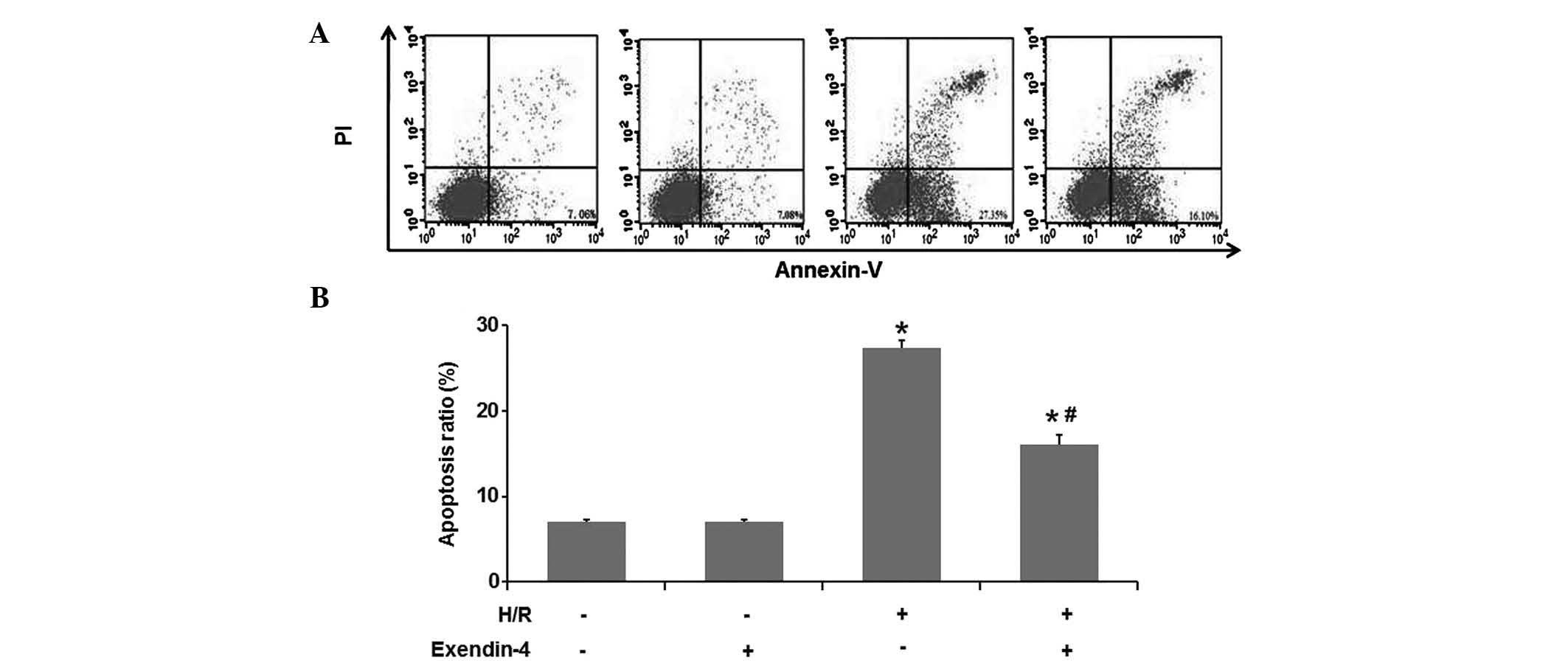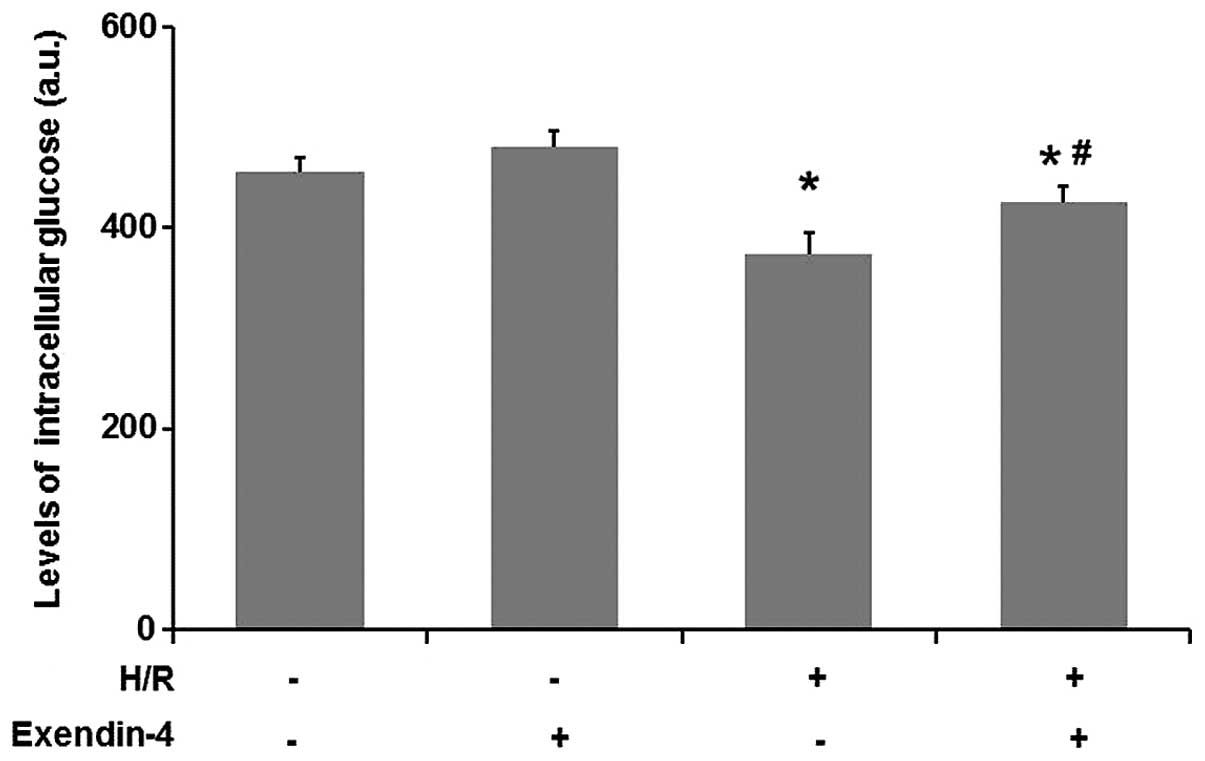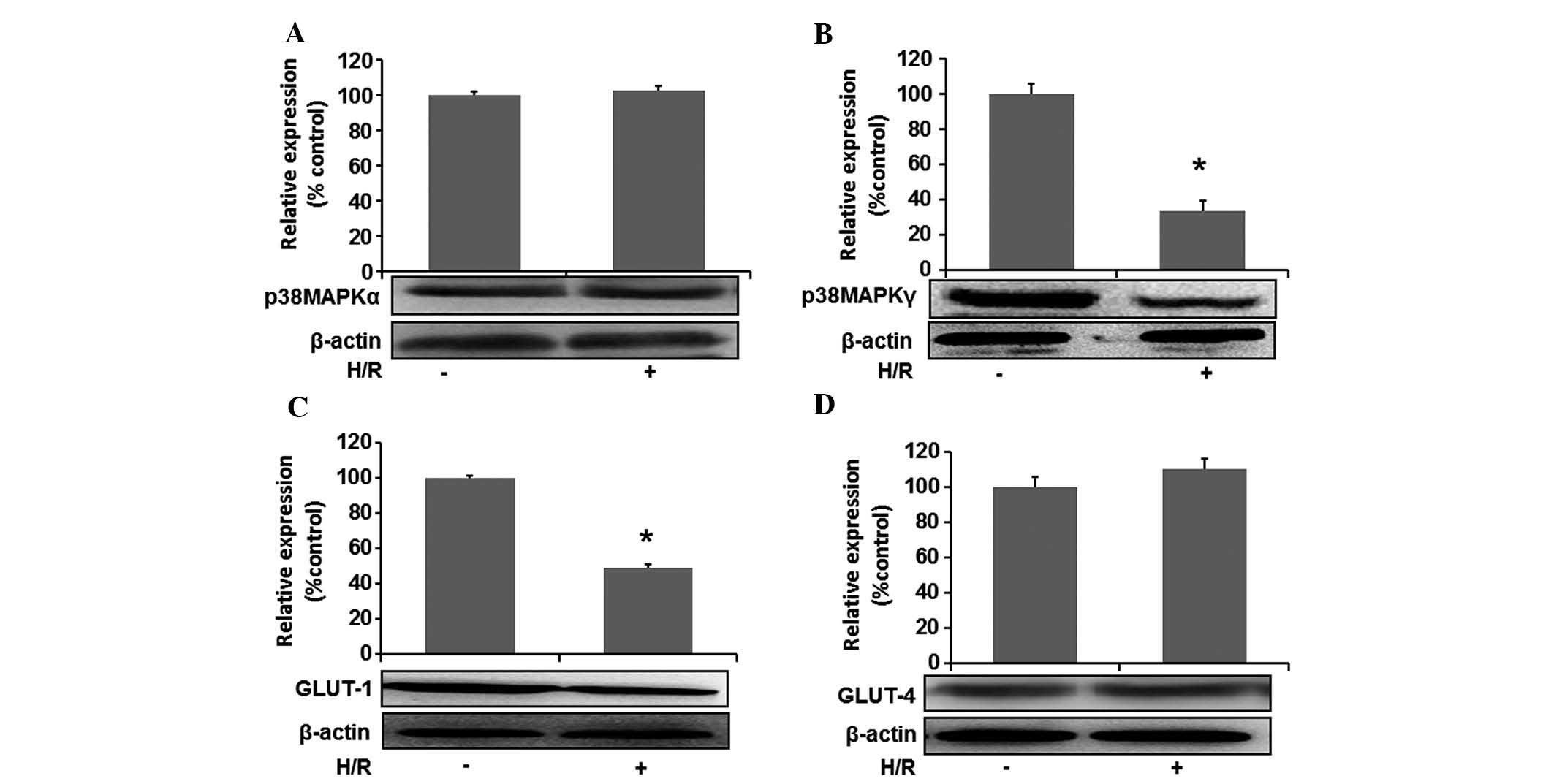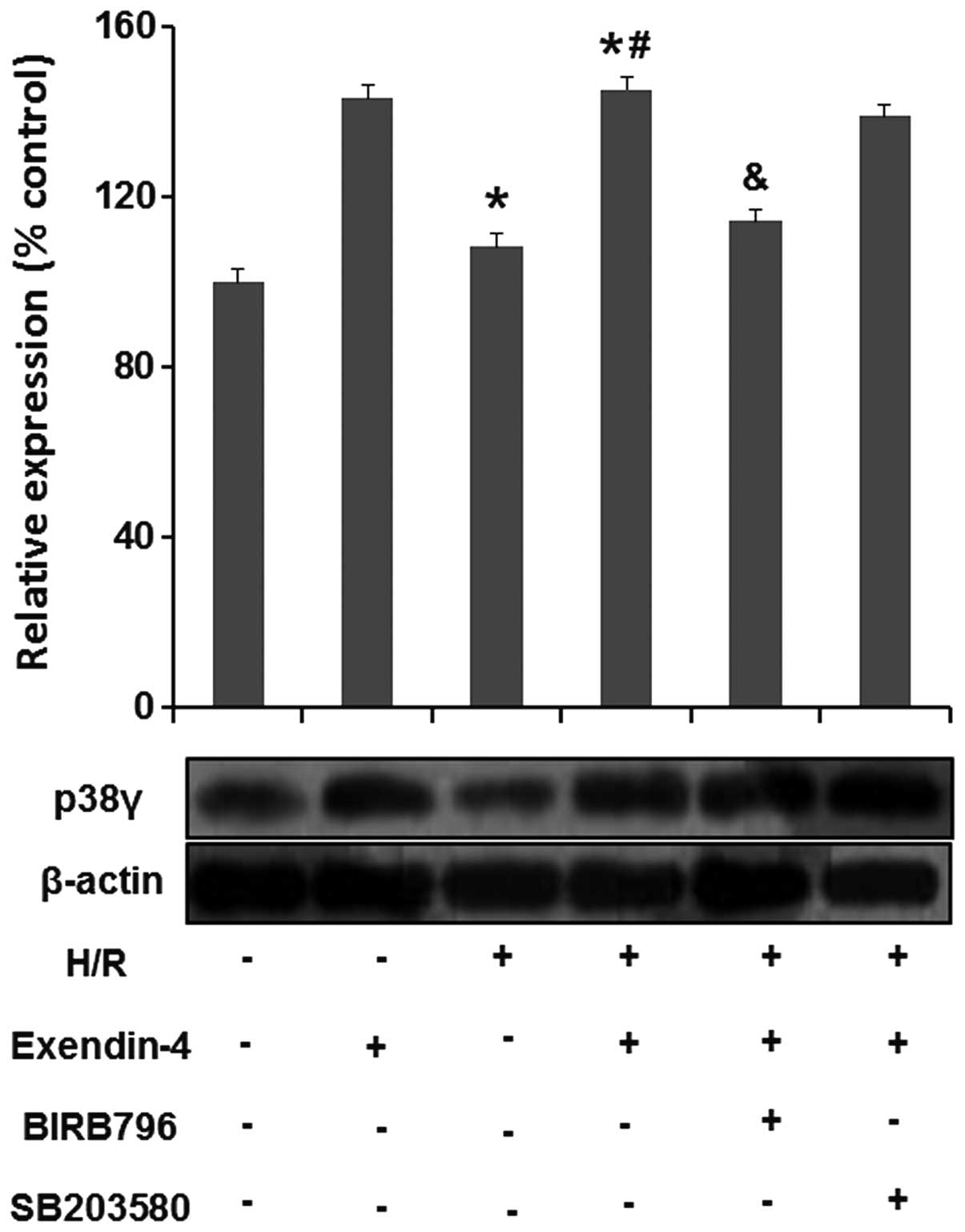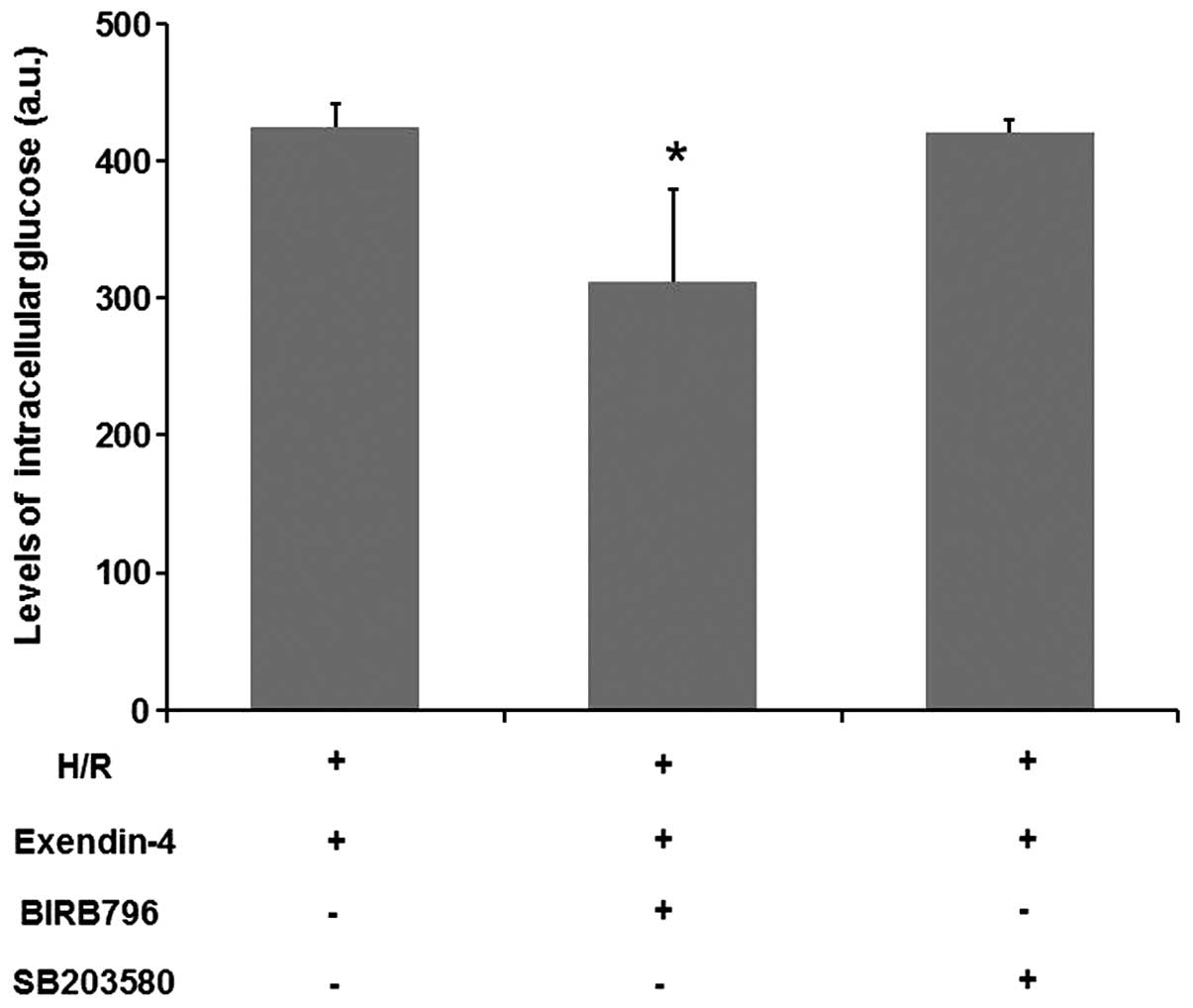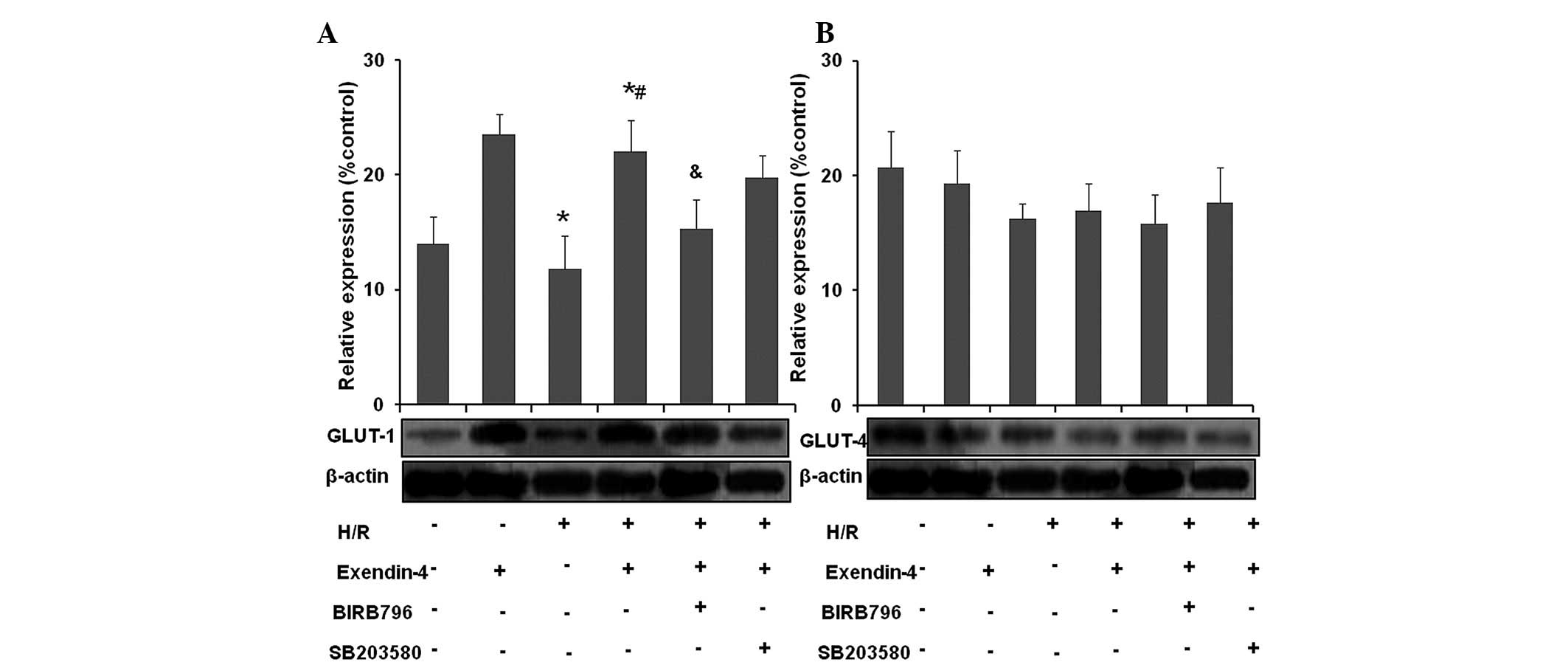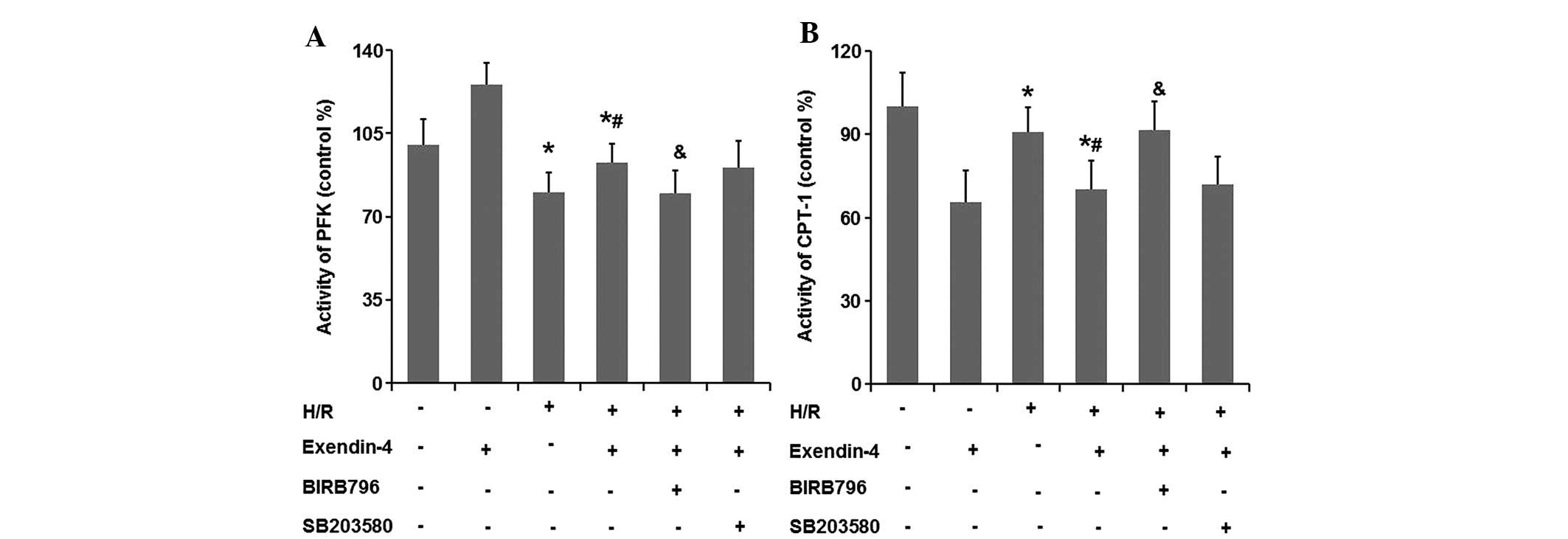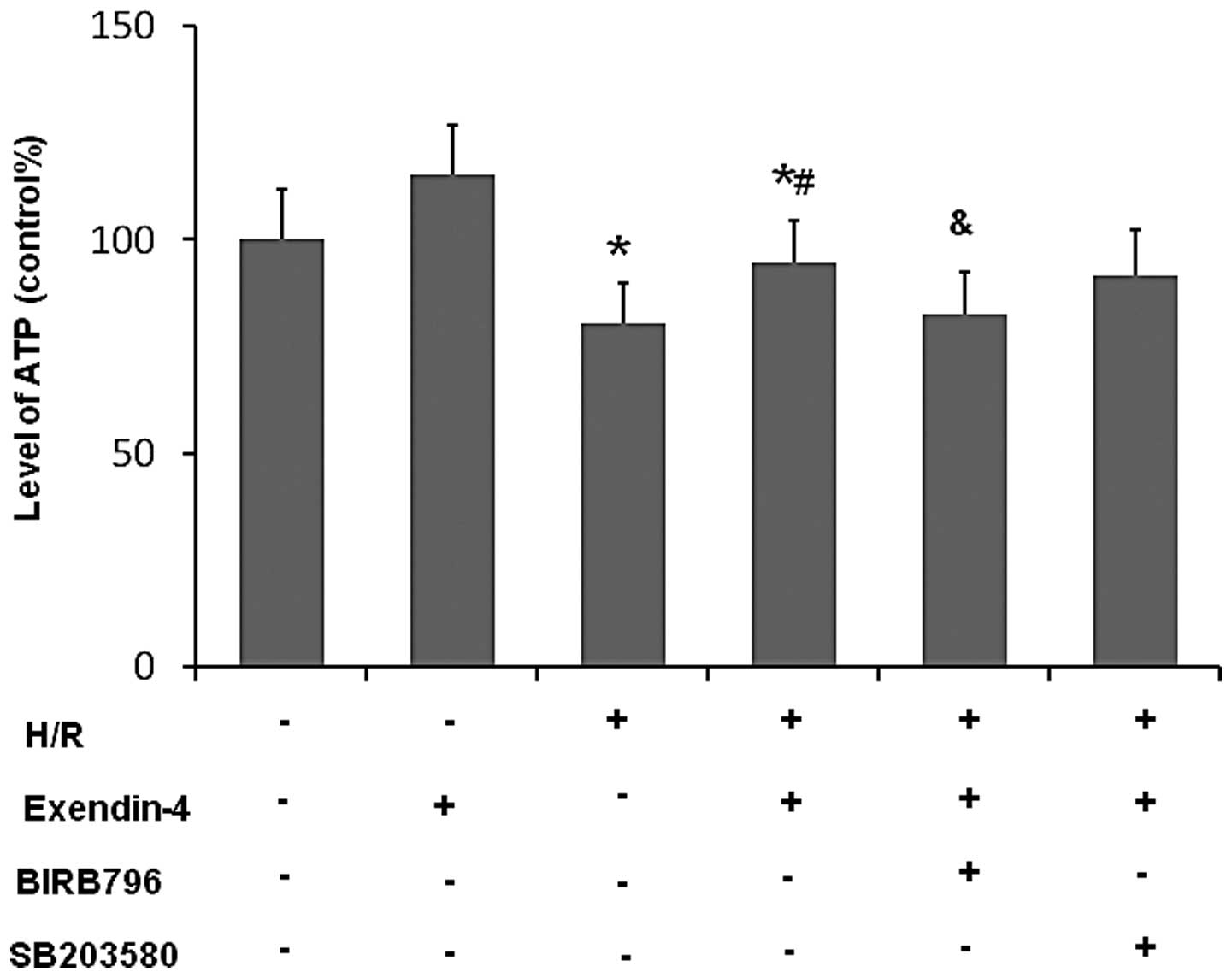|
1
|
Hütter JF and Soboll S: Role of fatty acid
metabolites in the development of myocardial ischemic damage. Int J
Biochem. 24:399–403. 1992. View Article : Google Scholar : PubMed/NCBI
|
|
2
|
Gambert S, Vergely C, Filomenko R, Moreau
D, Bettaieb A, Opie LH and Rochette L: Adverse effects of free
fatty acid associated with increased oxidative stress in
postischemic isolated rat hearts. Mol Cell Biochem. 283:147–152.
2006. View Article : Google Scholar : PubMed/NCBI
|
|
3
|
Grynberg A: Effectors of fatty acid
oxidation reduction: Promising new anti-ischaemic agents. Curr
Pharm Des. 11:489–509. 2005. View Article : Google Scholar : PubMed/NCBI
|
|
4
|
Avogaro A: Cardioprotective effects of
glucagon-like peptide-1: Preclinical and clinical data. G Ital
Cardiol (Rome). 12(Suppl 2): 17–24. 2011.In Italian.
|
|
5
|
Otto-Buczkowska E: Glucagon and
glucagon-like peptides the role in control glucose homeostasis.
Part I. Pediatr Endocrinol Diabetes Metab. 17:215–221. 2011.In
Polish.
|
|
6
|
Gallwitz B: Anorexigenic effects of GLP-1
and its analogues. Handb Exp Pharmacol. 209:185–207.
2012.PubMed/NCBI
|
|
7
|
Quintanilla-García C and Zúñiga-Guajardo
S: The incretin effect and type 2 diabetes. Rev Med Inst Mex Seguro
Soc. 48:509–520. 2010.In Spanish.
|
|
8
|
Lindamood CA and Taylor JR: Emerging new
therapies for the treatment of type 2 diabetes mellitus:
Glucagon-like peptide-1 receptor agonists. Clin Ther. Feb
3–2015.Epub ahead of print. View Article : Google Scholar : PubMed/NCBI
|
|
9
|
Harris KB and McCarty DJ: Efficacy and
tolerability of glucagon-like peptide-1 receptor agonists in
patients with type 2 diabetes mellitus. Ther Adv Endocrinol Metab.
6:3–18. 2015. View Article : Google Scholar : PubMed/NCBI
|
|
10
|
Bao W, Aravindhan K, Alsaid H, Chendrimada
T, Szapacs M, Citerone DR, Harpel MR, Willette RN, Lepore JJ and
Jucker BM: Albiglutide, a long lasting glucagon-like peptide-1
analog, protects the rat heart against ischemia/reperfusion injury:
Evidence for improving cardiac metabolic efficiency. PLoS One.
6:e235702011. View Article : Google Scholar : PubMed/NCBI
|
|
11
|
Bose AK, Mocanu MM, Carr RD, Brand CL and
Yellon DM: Glucagon-like peptide 1 can directly protect the heart
against ischemia/reperfusion injury. Diabetes. 54:146–151. 2005.
View Article : Google Scholar
|
|
12
|
Bose AK, Mocanu MM, Carr RD and Yellon DM:
Glucagon like peptide-1 is protective against myocardial
ischemia/reperfusion injury when given either as a preconditioning
mimetic or at reperfusion in an isolated rat heart model.
Cardiovasc Drugs Ther. 19:9–11. 2005. View Article : Google Scholar : PubMed/NCBI
|
|
13
|
Read PA, Khan FZ and Dutka DP:
Cardioprotection against ischaemia induced by dobutamine stress
using glucagon-like peptide-1 in patients with coronary artery
disease. Heart. 98:408–413. 2012. View Article : Google Scholar
|
|
14
|
Read PA, Hoole SP, White PA, Khan FZ,
O’Sullivan M, West NE and Dutka DP: A pilot study to assess whether
glucagon-like peptide-1 protects the heart from ischemic
dysfunction and attenuates stunning after coronary balloon
occlusion in humans. Circ Cardiovasc Interv. 4:266–272. 2011.
View Article : Google Scholar : PubMed/NCBI
|
|
15
|
Phong WY, Lin W, Rao SP, Dick T, Alonso S
and Pethe K: Characterization of phosphofructokinase activity in
Mycobacterium tuberculosis reveals that a functional glycolytic
carbon flow is necessary to limit the accumulation of toxic
metabolic intermediates under hypoxia. PLoS One. 8:e560372013.
View Article : Google Scholar : PubMed/NCBI
|
|
16
|
Idrovo JP, Yang WL, Nicastro J, Coppa GF
and Wang P: Stimulation of carnitine palmitoyltransferase 1
improves renal function and attenuates tissue damage after
ischemia/reperfusion. J Surg Res. 177:157–164. 2012. View Article : Google Scholar : PubMed/NCBI
|
|
17
|
Rajaram N, Frees AE, Fontanella AN, Zhong
J, Hansen K, Dewhirst MW and Ramanujam N: Delivery rate affects
uptake of a fluorescent glucose analog in murine metastatic breast
cancer. PLoS One. 8:e765242013. View Article : Google Scholar : PubMed/NCBI
|
|
18
|
Lee J and Chang JH: Facile and
high-efficient immobilization of histidinetagged multimeric protein
G on magnetic nanoparticles. Nanoscale Res Lett. 9:6642014.
View Article : Google Scholar
|
|
19
|
Ji L, Zhang X, Liu W, et al:
AMPK-regulated and Akt-dependent enhancement of glucose uptake is
essential in ischemic preconditioning-alleviated reperfusion
injury. PLoS One. 8:e699102013. View Article : Google Scholar : PubMed/NCBI
|
|
20
|
Moberly SP, Berwick ZC, Kohr M, Svendsen
M, Mather KJ and Tune JD: Intracoronary glucagon-like peptide 1
preferentially augments glucose uptake in ischemic myocardium
independent of changes in coronary flow. Exp Biol Med (Maywood).
237:334–342. 2012. View Article : Google Scholar
|
|
21
|
Gejl M, Søndergaard HM, Stecher C, Bibby
BM, Møller N, Bøtker HE, Hansen SB, Gjedde A, Rungby J and Brock B:
Exenatide alters myocardial glucose transport and uptake depending
on insulin resistance and increases myocardial blood flow in
patients with type 2 diabetes. J Clin Endocrinol Metab.
97:E1165–E1169. 2012. View Article : Google Scholar : PubMed/NCBI
|
|
22
|
Tani M and Neely JR: Role of intracellular
Na+ in Ca2+ overload and depressed recovery
of ventricular function of reperfused ischemic rat hearts. Possible
involvement of H+-Na+ and
Na+-Ca2+ exchange. Circ Res. 65:1045–1056.
1989. View Article : Google Scholar : PubMed/NCBI
|
|
23
|
Ferrari R, Pepi P, Ferrari F, et al:
Metabolic derangement in ischemic heart disease and its therapeutic
control. Am J Cardiol. 82:2K–13K. 1998. View Article : Google Scholar : PubMed/NCBI
|
|
24
|
Mor I, Cheung EC and Vousden KH: Control
of glycolysis through regulation of PFK1: Old friends and recent
additions. Cold Spring Harb Symp Quant Biol. 76:211–216. 2011.
View Article : Google Scholar : PubMed/NCBI
|
|
25
|
Aoi W, Naito Y and Yoshikawa T: Potential
role of oxidative protein modification in energy metabolism in
exercise. Subcell Biochem. 77:175–187. 2014.PubMed/NCBI
|
|
26
|
Nguyen TD, Shingu Y, Amorim PA, Schwarzer
M and Doenst T: Glucagon-like peptide-1 reduces contractile
function and fails to boost glucose utilization in normal hearts in
the presence of fatty acids. Int J Cardiol. 168:4085–4092. 2013.
View Article : Google Scholar : PubMed/NCBI
|
|
27
|
Zhao T, Parikh P, Bhashyam S, Bolukoglu H,
Poornima I, Shen YT and Shannon RP: Direct effects of glucagon-like
peptide-1 on myocardial contractility and glucose uptake in normal
and postischemic isolated rat hearts. J Pharmacol Exp Ther.
317:1106–1113. 2006. View Article : Google Scholar : PubMed/NCBI
|
|
28
|
Moberly SP, Mather KJ, Berwick ZC, Owen
MK, Goodwill AG, Casalini ED, Hutchins GD, Green MA, Ng Y,
Considine RV, et al: Impaired cardiometabolic responses to
glucagon-like peptide 1 in obesity and type 2 diabetes mellitus.
Basic Res Cardiol. 108:3652013. View Article : Google Scholar : PubMed/NCBI
|
|
29
|
Cuenda A and Rousseau S: p38 MAP-kinases
pathway regulation, function and role in human diseases. Biochim
Biophys Acta. 1773:1358–1375. 2007. View Article : Google Scholar : PubMed/NCBI
|
|
30
|
Erdogdu O, Eriksson L, Xu H, Sjöholm A,
Zhang Q and Nyström T: Exendin-4 protects endothelial cells from
lipoapoptosis by PKA, PI3K, eNOS, p38 MAPK, and JNK pathways. J Mol
Endocrinol. 50:229–241. 2013. View Article : Google Scholar : PubMed/NCBI
|
|
31
|
Xu H, Li HL, Niu ZY, Li GZ, Cao J and
Jiang YD: Involvement of p38 MAPK pathway in GLP-1-induced
inhibition of apoptosis in human umbilical vein endothelial cells.
Sheng Li Xue Bao. 64:444–448. 2012.In Chinese. PubMed/NCBI
|
|
32
|
Kawasaki Y, Harashima S, Sasaki M, Mukai
E, Nakamura Y, Harada N, Toyoda K, Hamasaki A, Yamane S, Yamada C,
et al: Exendin-4 protects pancreatic beta cells from the cytotoxic
effect of rapamycin by inhibiting JNK and p38 phosphorylation. Horm
Metab Res. 42:311–317. 2010. View Article : Google Scholar : PubMed/NCBI
|
|
33
|
Ho RC, Alcazar O, Fujii N, Hirshman MF and
Goodyear LJ: p38gamma MAPK regulation of glucose transporter
expression and glucose uptake in L6 myotubes and mouse skeletal
muscle. Am J Physiol Regul Integr Comp Physiol. 286:R342–R349.
2004. View Article : Google Scholar
|
|
34
|
Bhashyam S, Fields AV, Patterson B,
Testani JM, Chen L, Shen YT and Shannon RP: Glucagon-like peptide-1
increases myocardial glucose uptake via p38alpha MAP
kinasemediated, nitric oxide-dependent mechanisms in conscious dogs
with dilated cardiomyopathy. Circ Heart Fail. 3:512–521. 2010.
View Article : Google Scholar : PubMed/NCBI
|
|
35
|
Kuma Y, Sabio G, Bain J, Shpiro N, Márquez
R and Cuenda A: BIRB796 inhibits all p38 MAPK isoforms in vitro and
in vivo. J Biol Chem. 280:19472–19479. 2005. View Article : Google Scholar : PubMed/NCBI
|
|
36
|
Caverzasio J and Manen D: Essential role
of Wnt3a-mediated activation of mitogen-activated protein kinase
p38 for the stimulation of alkaline phosphatase activity and matrix
mineralization in C3H10T1/2 mesenchymal cells. Endocrinology.
148:5323–5330. 2007. View Article : Google Scholar : PubMed/NCBI
|
|
37
|
Dingar D, Merlen C, Grandy S, Gillis MA,
Villeneuve LR, Mamarbachi AM, Fiset C and Allen BG: Effect of
pressure overload-induced hypertrophy on the expression and
localization of p38 MAP kinase isoforms in the mouse heart. Cell
Signal. 22:1634–1644. 2010. View Article : Google Scholar : PubMed/NCBI
|
|
38
|
Huisamen B, Genade S and Lochner A:
Signalling pathways activated by glucagon-like peptide-1 (7–36)
amide in the rat heart and their role in protection against
ischaemia. Cardiovasc J Afr. 19:77–83. 2008.PubMed/NCBI
|
|
39
|
Vyas AK, Yang KC, Woo D, Tzekov A, Kovacs
A, Jay PY and Hruz PW: Exenatide improves glucose homeostasis and
prolongs survival in a murine model of dilated cardiomyopathy. PLoS
One. 6:e171782011. View Article : Google Scholar : PubMed/NCBI
|
|
40
|
Liu Q, Anderson C, Broyde A, Polizzi C,
Fernandez R, Baron A and Parkes DG: Glucagon-like peptide-1 and the
exenatide analogue AC3174 improve cardiac function, cardiac
remodeling, and survival in rats with chronic heart failure.
Cardiovasc Diabetol. 9:762010. View Article : Google Scholar : PubMed/NCBI
|
|
41
|
Arnés L, Moreno P, Nuche-Berenguer B,
Valverde I and Villanueva-Peñacarrillo ML: Effect of exendin-4
treatment upon glucose uptake parameters in rat liver and muscle,
in normal and type 2 diabetic state. Regul Pept. 153:88–92. 2009.
View Article : Google Scholar
|





